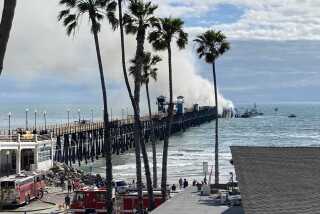State, Federal Water Supply Pact Reached
After 25 years of fitful, sometimes bitter negotiations, state and federal officials this week reached a historic agreement in managing Northern California water that will make it possible to ship additional amounts to Southern California and the San Joaquin Valley.
The agreement, which still must be ratified by Congress, could provide an added 400,000 acre-feet of water annually by 1988 through improving coordination between state and federal water projects, according to state officials.
In addition, the pact gives added protection to the environmentally fragile Sacramento-San Joaquin Delta and San Francisco Bay. For the first time, the federal government has agreed to a long-term commitment to shoulder part of the burden for sustaining delta water flows during dry periods.
The agreement, which was reached Monday, spells out the responsibility that the federal Bureau of Reclamation and the state Department of Water will have for providing water to flush out the delta and the bay in order to meet standards that have been set by the state Water Resources Control Board.
The safeguards are particularly important during drought years, when it is difficult to maintain the flows needed to protect fisheries and wildlife while meeting the needs of agricultural and urban users.
The federal water project, which has more water than it can deliver, is pledging its huge Northern California supplies to help maintain freshwater flows in the delta.
In return, the state, which has more delivery capacity than it has water, is agreeing to permit federal water to be shipped through state facilities to federal project customers in the San Joaquin Valley.
Under that agreement, the details of which still must be worked out, an estimated 200,000 acre-feet of additional water will be available to the customers of the federal Central Valley Project, and an additional 200,000 acre-feet will go to California Water Project customers south of the delta, said Robert James, chief counsel for the state water agency.
An acre-foot is enough water to supply the needs of a typical household for one year.
The federal government has as much as 1 million acre-feet of surplus water each year stored in its Northern California reservoirs, James explained. However, the state and federal governments can put all of the surplus water to use only if they build new facilities for moving it.
Canal Proposal Defeated
In 1982, however, the state’s voters soundly defeated an attempt to build the Peripheral Canal, which would have moved water around the delta and to the giant pumps of the California Water Project for shipment south. In addition, last year the Deukmejian Administration failed to win legislative approval for an alternative plan, which would have moved the water directly through the delta.
However, by working together, the state and federal water projects will be able to send more of the water south and still protect the delta and bay.
They will send more water south by filling existing state aqueducts with surplus federal water during dry seasons, when the state’s aqueducts do not normally operate at full capacity.
“This is an important, positive step,” said Thomas J. Graff, chief counsel for the Environmental Defense Fund. He noted, however, that the Water Resources Control Board is scheduled to set new water quality standards for the bay and delta by 1988. If those standards are tougher than the present ones, as Graff believes they should be, then much of the surplus water could be needed to flush out the delta and bay.
The Metropolitan Water District, which supplies water to much of Southern California outside of Los Angeles, is very supportive of the agreement, a spokesman for the district said. The MWD is fearful of losing close to 700,000 acre-feet, as Arizona takes an increasing share of Colorado River water between now and the end of the century.
More to Read
Start your day right
Sign up for Essential California for news, features and recommendations from the L.A. Times and beyond in your inbox six days a week.
You may occasionally receive promotional content from the Los Angeles Times.






